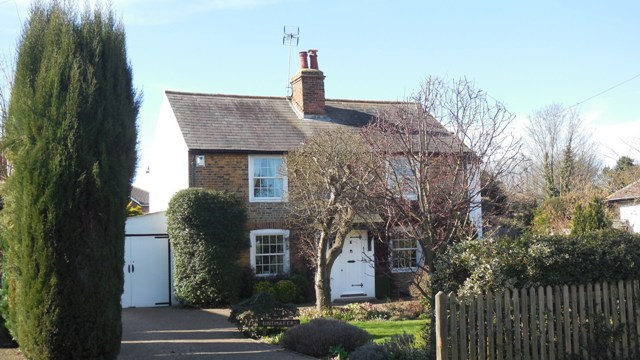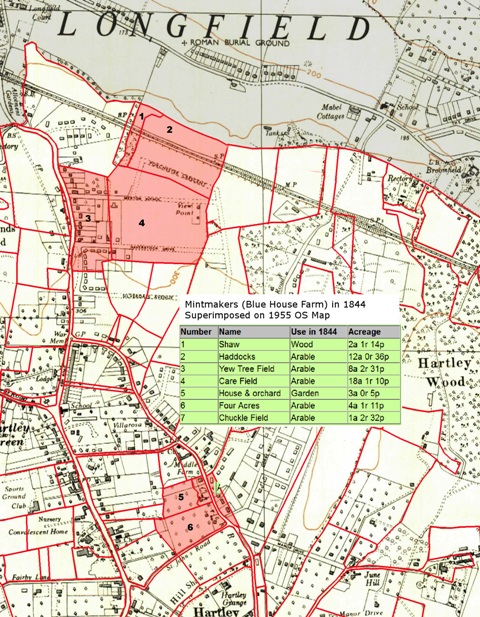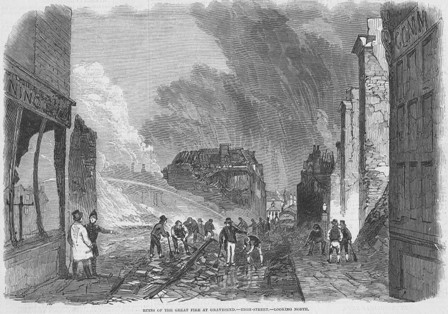Blue House Farm (Mintmakers)
Mintmakers, Church Road, where Blue House Farm used to be
Mintmakers was once the centre of a scattered farm of about 50 acres, which comprised land at Cherry Trees, Merton Avenue and the Wellfield Estate. Mintmakers is quite a modern name, and few places have undergone more changes of name. In its time it has been called "Bassedene", "St Peters", "Blue House Farm", "Armstrongs Farm" and "Willow Lodge". However the current owners (to whom I am indebted for much of the information here), assure me that they are not changing the name again!
The house is brick built and mid-Victorian in date, being originally two cottages. It is said that some of the window glass once belonged to the earlier house on the site. Originally it was two semi-detached cottages, which were converted into one building by Messrs Orpins in 1958. At this time the number of chimney pots was reduced from four to just one.
Our earliest reference to the farm is in 1495, when it was a mixed arable and pasture holding called "Bassedene" (after the field where Cherry Trees shops are now - perhaps the original house was here too?). It apparently belonged to the Cotyer family since at least the will of John Cotyer in 1452, but was then being purchased with Woodins by John Sedley of Southfleet from executors. Like Woodins this too had come into the hands of the Overy family of Fairby house by the mid 16th century. When the estate was partitioned between the brothers John and Richard Overy in 1604, it was John who received the cottage called "St Peters" in the occupation of John Comfort, and the other lands which made up the farm.
Map showing Blue House Farm
As is so common in the history of Hartley, we now have a break in our knowledge of the ownership, but we know that by 1668 it had come into the hands of one Henry Stacey, gentleman (apparently not the rector of Hartley of the same name). In that year he sold Mintmakers, together with land at Gravesend and Milton and ferry rights across the Thames to Lawrence Holker of Gravesend. His family was to own Mintmakers until the 19th century. Lawrence died in 1708 and in his will he left "my two several messuages or tenements with barns, stables, outhouses, lands, woodlands and appurtenances... in Hartley... in the several tenures or occupations of William Wigzall and Jeremiah Pead". Lawrence's home in Gravesend still exists; once called the Two Brewers, it is now the New Inn in Milton Road. His grandson Dr Laurence Holker, a physician, added to the family estates by this marriage to the heiress Katharine Allen. In 1734 Dr Holker had distinguished visitors at his Gravesend house - none other than the Prince of Orange and his new wife Anne, the daughter of George II, while they were waiting for better weather to sail to Holland. The Universal Journal reported that Gravesend had never known crowds like it before, to greet the royal couple.
After the death of another Lawrence Holker, who was an attorney in London, in 1794, Mintmakers descended to his two nieces Catherine Megginson and Ethel Potts. They were the daughters of John Thorpe of Bourne House, Bexley, who had married Lawrence's sister Catherine. John Thorpe was the famous antiquarian who compiled the records of Rochester Diocese in 1769, Lawrence acting as an agent for the book (Kentish Gazette 1.3.1769). It was probably on his return from Mr Thorpe's house in 1786 that Lawrence's coachman had the lamp shot out of his hand by an unknown assailant (Kentish Gazette 14.3.1786). Ethel Potts had two children, one of whom Laurence Holker Potts (1789 - 1850) is famous for patenting a mechanical process of sinking foundations by compressed air, still used today.
Mintmakers was purchased, together with Brickend in Church Road (which had also come into the hands of the Holker family at some point), by the then lessee, John Swaisland of Idleigh in 1815. Around 1840 he leased the farm to William Armstrong, after whom the farm was named for a time. Although he too sublet the house. For many years the Longhurst family lived here, and at the time of the 1891 Census one of the occupants was PC Walter Humphrey and his family.
James Swaisland was the owner, when he died in 1851. He left it to his nephews and niece William Wingfield Armstrong, James Armstrong of Southfleet, Mary Ann Armstrong. James bought out the others the following year. By conveyance dated 8 April 1863 he sold nearly all the estate to James Thomas Smith for £3,500, who purchased a large estate in Hartley, which he sold to James Timmins Chance in 1899. JT Chance died in 1902 and his beneficiaries sold the Hartley estate to Thomas Morton on 10 October 1905, just weeks later he had sold 122 acres of that to Payne Trapps & Co.
From the Parish Rating Book which survives from 1744, the tenants of the farm were: Edward Thorpe (1744-1779), Edward Thorpe (1780-1781), Richard Treadwell (1781-1798), John Swaisland (1798-1836), William Armstrong (1839-1852), James Armstrong (1855-1863).
The original house burnt down on the morning of Friday 3rd October 1851 and the present building constructed in its stead. According to the South Eastern Gazette "A fire of a very destructive character broke out on Friday morning, the 3rd inst., upon the farm of Mr Armstrong, of Hartley. The Gravesend engine was in attendance, but nearly all the property upon the farm was consumed. It is believed to be the work of an incendiary. The property is insured in the Norwich and Kent Fire Offices."
The "Wellfield" part of the estate was bought by Payne Trapps & Co on 1 November 1905, while Smallowners Ltd acquired the Church Road lands. The latter lands became "Cherry Orchard Farm", a mixed poultry and fruit holding owned by the Campkin brothers. The last vestiges of the farm attached to the house vanished in 1929, when the then owner Miss Davies-Cooke sold the 1½ acre orchard at the back to the Campkins.
In the early part of this century Mintmakers was known as "Willow Lodge", in the 1930s it was almost hidden from the road by trees and there was a pond in the front garden. It has changed hands a number of times, and has been owned or occupied by a number of well known Hartley families, including Tom Tate, Frank Crouch and Thomas Hockley. Mr Hockley was living there in 1933 when he witnessed the getaway car of a burglary at Spinney Corner (now Preet Niwas) opposite, his information enabled the police to catch the robbers. From 1960 to 1965 Mr and Mrs Luboff lived here; he worked for the Bank of England, and this no doubt explains the change to its current name, although an alternative explanation claims it was so called after he had spent a mint on it!
Source Documents
Calendar
of Close Rolls 10 Henry VII (1495)
John Sedley appears to be buying Blue House Farm (Bassdeane) and Woodins (Hayes). But in times past the buyer of a freehold was always worried that some unknown interest that would later affect their title to the land. So John gets release of interest (quitclaim) from the descendants of the executors and feoffees of John Cotyer who died in 1452.
(p
244 m16d) William and Robert Hancok to John Sedley, auditor of the
exchequer, his heirs and assigns. Release and quitclaim with
warranty of all lands and tenements situated in the parish of Hartley
called Hayes formerly of John Cotyer. Dated 26 January 10 Henry VII,
1495.
(p
250 m21d) Clement Bond, labourer of Herteley, and John Bond, turnour
of London, executors of John Bond, rector of Herteley, to John
Sedley, auditor of the exchequer, his heirs and assigns. Release and
quitclaim with warranty of Hayes tenement containing 23 acres of
arable land, and Bassedene tenement, containing 35 acres of arable
land and pasture lying in the parish of Hertley aforesaid. Dated 6
May 10 Henry VII, 1495
Deed
of Partition 29 September 1604
The brothers John and Richard Overy had inherited a large estate in Hartley from their father Abraham, and this deed was to divide the estate between them. The elder brother John got Fairby Farm and St Peters (later called Blue House Farm). This is the earliest reference to the field names.
This
indenture made the six and twentieth day of September in the year of
the reign of our sovereign lord James by the grace of God of England,
Scotland, France and Ireland king, defender of the faith etc. viz. of
England, France and Ireland the second, and of Scotland the eight and
thirtieth. Between John Overy of Hartly in the county of Kent,
yeoman, one of the sons of Abraham Overy late of Hartly aforesaid,
deceased, of the one part. And Richard Overy of Hartly aforesaid,
yeoman, one other of the sons of the said Abraham Overy, of the other
part. Witnesseth that whereas John Overy, late of Hartly deceased,
the great-grandfather of the said John and Richard Overy, being
seized in his demesne as of fee of and in four messuages or
tenements, four gardens, four orchards and 186 acres of arable lands,
pasture and wood more or less with the appurtenances in Hartly
aforesaid, by his will and testament in writing bearing date the 16th
day of July in the year of our Lord 1555 (amongst other things) did
devise the said messuages, lands and tenements with the appurtenances
unto Richard Overy his son for life and the reversion or remainder
thereof after his death to the said Abraham his son, and to the heirs
males of his body lawfully begotten. Which Abraham being seized of
the premises by force of the said gift and having issue male of his
body lawfully begotten, the said John Overy and Richard Overy,
parties to these presents, thereof afterwards died seized. After
whose death the same John and Richard Overy his sons entered into the
premises and occupied the same together in common and undivided until
now of late time, when by their mutual consent and agreement with the
advice and assistance of their friends, a perfect partition and
division, according to the laws of this realm was had and made
betwixt them of the said messuages, lands and tenements with the
appurtenances. And that in manner and form following: that is to
say.
.........................
That
the said John Overy, one of the parties to these presents, should
have hold and enjoy to him and his heirs forever in severality of and
in full satisfaction of his part, purpart or moiety.
All that messuage or tenement called Farbyes
... And also one other messuage, tenement or cottage with the
appurtenances called St
Peter and 2½ acres of
ground more or less thereunto belonging, now or late in the
occupation of John Comfort, with these parcels also of ground
following, viz. Yewfeild, containing 6 acres more or less, Care Hill
containing 13 acres more or less, Basedeane containing 4 acres more
or less, and Greate Huttocks and Little Huttock with the springs
thereunto adjoining containing together by estimation 10 acres more
or less. Into which premises last rented, assigned and allotted to
the said John Overy for his part purpart or moiety, he the same John
hath entered and is now seized thereof in severality according to the
said partition.
..........................
Feet
of Fine 1668
TNA CP25/2 671(Easter 20 Charles II, 1668)
Feet of fines are fictional court cases to record the evidence of a conveyance.
Between
Laurence Holker gentleman, plaintiff, and Henry Stacey gentleman,
deforciant, of 5 messuages, 1 brew house, 4 barns, 3 stables, 4
yards, 2 wharfs, 5 gardens, 3 orchards, 50 acres 1 rood of land, 10
acres of pasture and the passage of the River Thames in Hartley,
Gravesend and Milton next Gravesend.
Will of Lawrence Holker of Gravesend, gentleman (1708)
He leaves his soul to Almighty God.
His wife Susanna to get all tenements, messuages, lands etc in Grevesend, Milton next Gravesend, Northfleet, and Hartley. Also the land originally leased to his father in Lancashire, and the use of all his household goods. After her death, his eldest son Laurence to get messuage, tenement and wharf, called “Two Brewers” in Gravesend; and “my two several messuages or tenements with barns, stables, outhouses, lands, woodlands, and appurtenances2 in Hartley2 in the several tenures or occupations of William Wigzall and Jeremiah Pead”.
Provision also for younger son John.
Dated 3 September 1708
Proved (London) 2 November 1708
Robert Pocock in his history of Gravesend mentions Lawrence's grave at St George's Church, Gravesend which was lost in the fire of 1727.
"Here
lyeth interred the body of Lawrence Holker, gent. who departed this
life the 16th day of October 1708 in the 78th year of his age. And
also his daughter Susannah, who died in October 1679 aged 3 years and
3 months. And also his son Lawrence, who died the 28th day of
December 1704 aged 39 years. Also the body of Susannah Fewtrell, his
granddaughter, who departed this life the 10th day of October 1709
aged 24 years. Also his dear daughter Susannah Holker, who departed
this life the 20th December 1709 in the 69th year of her age."
Will
of Lawrence Holker of Milton next Gravesend, doctor in physick (1738)
He
leaves his “poor and immoral soul” to Almighty God, in the hope
of pardon by merits of Jesus Christ.
To
his wife Katherine: he leaves all his lands in Gravesend and
elsewhere, that belonged to his father, except the jointure estate
and the parts that belonged to her late father and brother Mr Stephen
Allen the elder and younger, and of her late cousin Mr Richard Wood.
Jointure estate of wife set up by deed dated 6 February 1727, made
between (1) Lawrence and Katherine Holker (2) John Holker esq and
William Mann (trustees) of land at Frindsbury, Cobham, Meopham and
Luddesdowne.
Katherine
to hold lands on trust for their children, if she dies before they
reach 21 then trustees to hold land instead for children. Reversion
to his son Lawrence, who is to pay annuity of £50 to his
sister Katherine and £1,500 when she reaches 21. Next
reversion to daughter Katherine, then to his brother Thomas if both
children die before they are 21.
Personal
estate to wife. If she remarries and claims the £500 that she is
entitled to under marriage articles, then personal goods to go to his
trustees.
Dated
10 June 1738 (John Tasker is one of the witnesses)
Proved
(London) 13 June 1738
Will
of Lawrence Holker of St Thomas Apostle, London (1794)
To
each of the city of London’s common council and to each of his
cousins | a mourning ring.
To
brother in law John Thorpe and his wife and daughter | a ring.
To
servant Susanna Allen | a ring and annuity of 10 guineas,
charged on his farm at Hook Green, Meopham.
Real
estate belonging to his honoured brother for her (his mother?)
natural life, and then to his sister Catherine Thorpe, and
then to her children.
Mother
aforesaid appointed executor.
Dated
before 1779 (4 codicils not checked yet)
Proved
(London) 12 March 1794
Report of Fire at Blue House Farm (Kentish Independent 11 October 1851)
On the following morning [Friday 3rd October] about 12 o'clock an express came over fro the village of Hartley for the engine, Mr Aitkin with his brigade and the engine proceeded there with all possible dispatch and found a fire raging at the farm of Mr James Armstrong, at Hartley Bottom (sic); 2 cottages, a barn, a stack of oats, and another of peas and a cart lodge in which the fire broke out were entirely destroyed when the engine arrived; and it was feared that the adjoining far hous which was only separated by a small orchard, would share the same fate, but fortunately that was saved. The property was insured in the Norwich and Kent offices; the liability of the Norwich Office is, we believe, about £600.
Picture of Gravesend Fire Brigade in Action 1850



